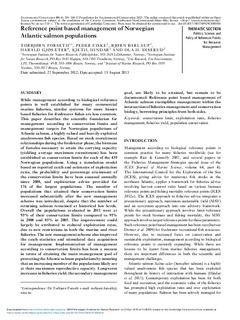| dc.description.abstract | While management according to biological reference points is well established for many commercial marine fisheries, similar systems for more leisure based fisheries for freshwater fishes are less common. This paper describes the scientific foundation for management according to conservation limits and management targets for Norwegian populations of Atlantic salmon, a highly valued and heavily exploited anadromous fish species. Based on stock recruitment relationships during the freshwater phase, the biomass of females necessary to attain the carrying capacity (yielding average maximum recruitment) has been established as conservation limits for each of the 439 Norwegian populations. Using a simulation model based on reported catch and estimates of exploitation rates, the probability and percentage attainment of the conservation limits have been assessed annually since 2008, and exploitation advice provided for 176 of the largest populations. The number of populations that attained their conservation limits increased substantially after the new management scheme was introduced, despite that the number of returning salmon remained at historical low levels. Overall the populations evaluated in 2011 were at 95% of their conservation limits compared to 91% in 2008 and 85% in 2005. The improvement could largely be attributed to reduced exploitation rates, due to new restrictions in both the marine and river fisheries. The newmanagement scheme also improved the catch statistics and stimulated data acquisition for management. Implementation of management according to conservation limits has been a success in terms of attaining the main management goal of protecting the Atlantic salmon populations by ensuring that an increasing number of the populations likely are at their maximum reproductive capacity. Long-term increases in fisheries yield, the secondary management goal, are likely to be attained, but remain to be documented. Reference point based management of Atlantic salmon exemplifies management within the intersection of fisheriesmanagement and conservation biology, borrowing principles from both sides. conservation limit, exploitation rates, fisheries management, fisheries yield, population conservation | |
